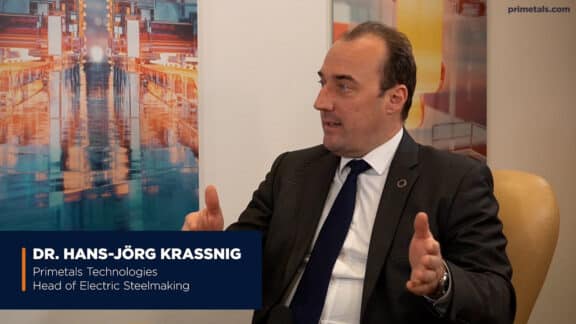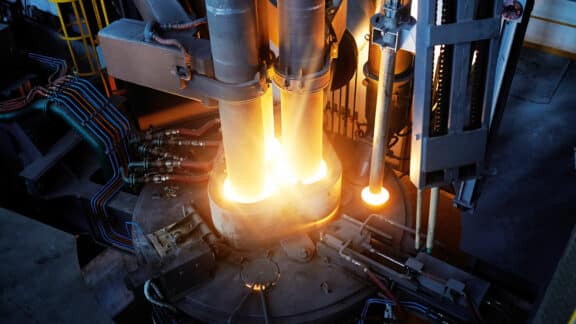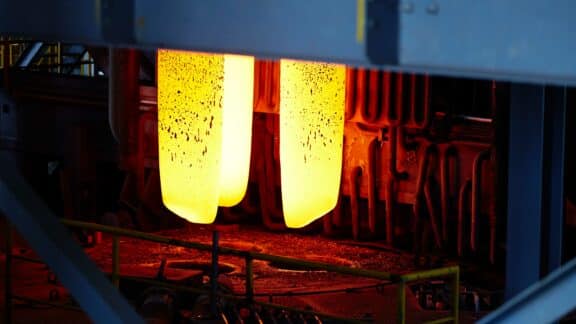The first EAF Quantum startup at Tyasa in 2014 marked a technological leap in the status quo of electric steelmaking and arc furnace design. In the following decade, the EAF Quantum continued to improve advances in shaft-based electric steelmaking. It has become key to the steel industry’s sustainable and eco-friendly future. With an increased focus on flexible charge mixes for optimal steel quality, blending new input material with scrap metal allows producers to tackle demanding limitations regarding power and performance. The revolutionary EAF Quantum is a game-changer in electric steelmaking.
ELECTRIC STEELMAKING REIMAGINED
The development of a shaft-based electric arc furnace at Primetals Technologies began in the 1980s. Twenty years later, the fourth generation of a preheating shaft technology installed at Stahl Gerlafingen in Switzerland in 2008 highlighted the potential of this technology. Six years later, Primetals Technologies unveiled the first EAF Quantum at Tyasa in Mexico. The year 2014 marked the beginning of a new legacy of EAF Quantum implementations amounting to 14 EAF Quantums worldwide, with two new furnaces set to come into operation soon.
What began as the pursuit of an optimized shaft furnace became the groundbreaking conception and implementation of a highly efficient and optimized furnace with low environmental impact and substantially reduced disturbances to the electrical grid. The EAF Quantum combined previous strengths in scrap preheating technologies from the shaft-based electric arc furnace with flat bath operation and an innovative scrap handling and automation scheme. Since 2014, these features of the EAF Quantum have been continuously innovated, making it the leading energy-efficient and high-performing furnace of the twenty-first century.
DESIGN PARAMETERS
Tap weight (tons)
100
150
220
300
Transformer (MVA)
80
120
160
190
PERFORMANCE VALUES1)
Power-on time (minutes)
28
28
33
40
Tap-to-tap time (minutes)
32
32
38
48
Heats per day
45
45
38
30
Productivity (tons/hour)
188
281
347
379
CONSUMPTION VALUES1)
Electricity (kWh/ton)
290
290
300
300
Electrodes
0.7 kg/ton
Oxygen
30 Nm3/ton
1) Exemplary expected performance values are for 100 percent scrap operation
EFFICIENT MATERIAL BLENDING
Today, the global trend of “green steel” is motivating steel producers to transform their production routes toward eco-friendly solutions while maintaining high production and pushing quality levels to meet changing requirements in, for example, the automotive and energy sectors. The EAF Quantum meets these demands by providing flexibility regarding charge materials, such as hot metal, pig iron, direct reduced iron (DRI), and hot-briquetted iron (HBI). All these alternative materials help producers overcome quality hurdles when working with a high percentage of crafted scrap.
With capacities rivaling 300-plus-ton converters and high energy efficiency, the EAF Quantum is the frontrunner of eco-friendly steel production.
The EAF Quantum improves yield and efficiency through preheating. In operation, scrap and qualified material is brought from the scrapyard to the charging chute via an elevator system. Once inside the shaft, off-gas from the ongoing production process preheats the scrap, reducing the energy required to melt the scrap upon charging. The waste energy content a typical electric arc furnace generates is approximately 150 kilowatt-hours per ton, which is captured and recycled into the preheating shaft.
The Active Power Feeder utilizes a high-speed electronic actuator, or “modular multilevel converter,” to supply balanced power from the supplying medium voltage bus to the electric arc furnace in the most “grid-friendly” way. The modular multilevel converter design allows for low electrical losses, low harmonic distortion, and controlled voltage and current shapes of variable frequencies.
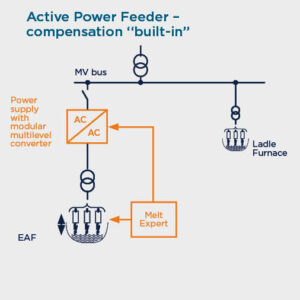
- Symmetrical load of MV bus
- Fast, stepless current control with converter
- Possibility to compensate additional ladle furnace (see above)
Additionally, dust emissions are reduced by 50 percent as the off-gas passes through the scrap pillar during preheating. The reduction in emissions also correlates with increased zinc absorption from the off-gas, found as zinc oxide and zinc ferrite in the dust from an electric arc furnace. An increased zinc content in the collected dust can benefit the recycling and resale of recovered zinc and other by-products from the electric arc furnace dust.
Once the preheated stack reaches the optimal temperature in the shaft, the so-called “fingers” are moved completely out of the preheating chamber, and the scrap is released into the liquid bath. When the preheated scrap encounters the hot heel, the melting rate and temperature balance benefit from the additional bottom stirring system, resulting in a highly efficient operation requiring less electrical energy. The use of waste heat for scrap preheating and the maximal energy-efficient operation makes the EAF Quantum part of the Best Available Techniques in steelmaking.
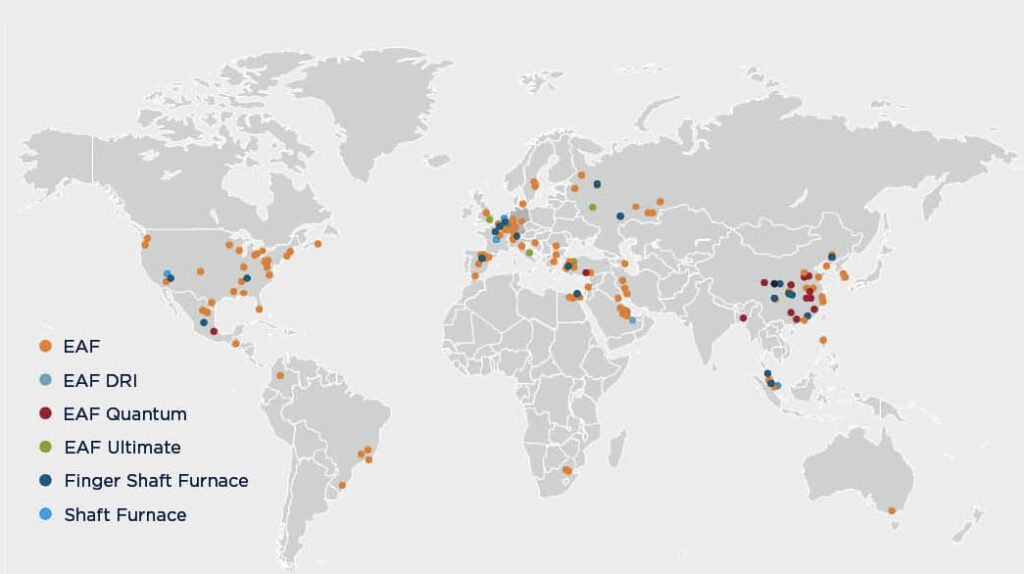
FLAT BATH AND CLOSED ROOF
Scrap charging into the operating furnace via the innovative shaft is done at the best charging point. Consequently, the EAF Quantum always operates under ideal flat-bath conditions. The flat bath and closed roof operation of the EAF Quantum allow for optimal melting conditions, exceptionally low impact on the grid and flicker generation, and improved productivity thanks to the ability to charge, tap, and prepare the taphole during power-on conditions. These features benefit producers regarding electrical consumption and extend the effective electric arc furnace production time. Flat bath operation achieves a higher average active power than a conventional electric arc furnace for the same transformer rating. The results are increased productivity and yield while reducing power consumption and conversion costs.
The EAF Quantum provides an impactful solution for steel producers transitioning from an integrated steel plant operating with a basic oxygen furnace (BOF) toward electric steelmaking. Thanks to a reduction in power consumption and a low-power transformer, producers will see a reduction in Scope 2 Carbon Emissions—i.e., emissions produced through purchased electricity—which are an increasing concern for carbon pricing schemes and a reduction of direct emissions. (For more on scope emissions, read “The Full Scope: Understanding the Scope Emissions”)
While the increased use of scrap in steelmaking comes with the benefits of lessening the environmental impact of production, an increase in nitrogen content levels may also present challenges to steel producers. Nitrogen, an element in steel, is an essential part of the alloying process and is found in steel during production. However, high amounts of nitrogen lead to inconsistent mechanical properties, particularly embrittling effects in hot-rolled steels and poor ductility in certain cold-rolled steels.
Thus, keeping nitrogen levels within an optimal range comes down to using low-nitrogen charging materials and reducing nitrogen pickup through the electric arc melting process and furnace design. For the EAF Quantum, this amounts to a short arc length and arc time. The stability from slag foaming is increased thanks to the charging of preheated batches of scrap. Finally, the air-tight furnace operation creates a high carbon monoxide atmosphere, providing low nitrogen partial pressure. With these design features, the EAF Quantum provides producers with optimal control for low nitrogen levels in steel production.
Flat bath operation reduces the impact on the overall power grid significantly. Flicker reduction and minimizing harmonic disturbances are relevant for worldwide electrical grids and electricity suppliers. While it is an early stage as producers transition from converter steelmaking to electric steelmaking, energy providers are coping with grid expansion and the integration of renewable energy technologies, such as wind and solar. As the adoption of electric arc furnaces increases, investment costs for grid coupling and VAR compensation will decrease.
Active Power Feeder and FAST
The Active Power Feeder, in combination with the electrode control system, Melt Expert, from Primetals Technologies, ensures the electric arc furnaces operate at optimal levels concerning energy input and minimal electrode consumption. Using stored meltdown profiles and process models for various process phases, the Melt Expert and EAF Optimizer—a Level 2 automation system—support operators with fully automated control functions throughout each phase.
Beyond flat bath operation, the closed-roof operation has noticeable benefits in reduced power-on time, lower energy losses, and less nitrogen pickup of the steel bath. Additionally, the EAF Quantum features the Furnace Advanced Slag-free Tapping (FAST) system. This integrated siphon-type tapping system eliminates the adverse effects of slag passing to the teeming ladle. The FAST system allows for tapping and tap hole filling under power-on conditions.

Susanne Schillinger is a member of the
German-based design team for electric arc furnaces, including the EAF Quantum.
How does Primetals Technologies appraoch electric arc furnace design?
Susanne Schillinger: The engineering team considers all our customers’ needs when designing and constructing an electric arc furnace. When we look at the plant layout, we aim to provide producers with a solution that meets all their requirements and parameters. What typically starts as a basic proposal transforms into a tailor-made solution for steel producers.
Why is an electric arc furnace from Primetals Technologies so unique?
Schillinger: Research and development is part of our project DNA. As we adjust our engineering designs for our customers and collaborate across multiple teams, innovations to the electric arc furnace are further implemented into the design. Our furnace designs are built to last. Therefore, what may have been optimal in an initial design is truly optimized by the time the project is finished.
What makes your work exciting?
Schillinger: Apart from working with various teams and continuously collaborating, we are fueled by our passion. Having the entire plant layout at my fingertips, seeing the movement and interaction of components, and watching them work together, I am ecstatic at the opportunity to deliver the best possible solution to my team and customers.
Transitioning the Industry
The EAF Quantum has proven time and time again to be an ideal electric arc furnace with exceptional performance at references worldwide. Most recently, two 150-ton EAF Quantums in Türkiye have expanded a steel plant’s capacity to four million metric tons of crude steel per year and reached performance levels of 270 tons per hour. However, seeing demand grow for increased yield, productivity, and quality from electric steelmaking, specialists at Primetals Technologies have innovated the EAF Quantum for the next generation.
Drawing on successes with larger electric arc furnaces boasting tapping weights of over 300 tons, specialists at Primetals Technologies have combined the cutting-edge technology in the EAF Quantum with a higher tapping weight and capacity to provide an electric arc furnace for the transition to “green steel” and eco-friendly steel production. This furnace type provides producers with comparable tapping weights at levels rivaling those of a standard large-scale BOF.
As producers begin to replace existing blast furnaces and converter-based production routes, pressing questions surrounding yield and energy efficiency are answered by the EAF Quantum. Adaptable to various charge materials and offering precision automation across all aspects of the production process, the EAF Quantum is one of the most advanced furnaces worldwide. With capacities rivaling 300-plus-ton converters and high energy efficiency, the EAF Quantum is the frontrunner in eco-friendly steel production.
